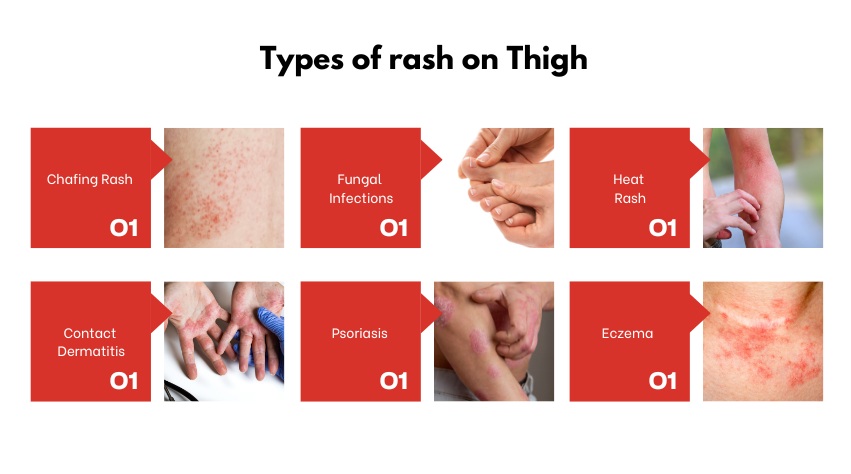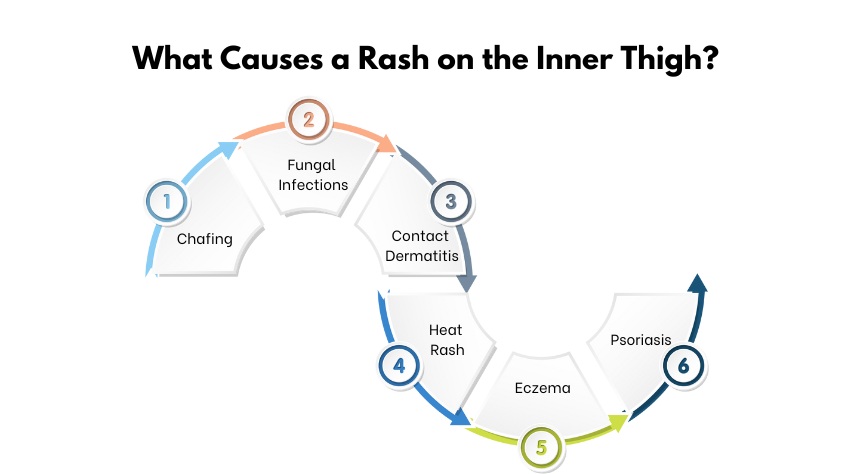A rash on the inner thigh is a common issue that can affect anyone, but it’s particularly prevalent among athletes, active individuals, and those who spend long periods in humid or sweaty environments. Both men and women are equally susceptible to this uncomfortable condition, which can be caused by a variety of factors, including friction, fungal infections, or allergic reactions.
Understanding the root causes and symptoms is crucial for effective treatment and prevention. Whether you are a sports enthusiast constantly on the move or simply someone experiencing this irritation, this guide will provide you with the essential knowledge to manage and alleviate inner thigh rashes effectively.
Are Thigh Rashes Normal?
Thigh rashes are quite normal and can occur for a variety of reasons. While they might be a nuisance, especially for those leading active lifestyles, they’re usually not a cause for serious concern. The inner thighs are prone to friction, sweating, and heat, creating an environment where rashes can easily develop.
Common causes include chafing from clothing or skin-to-skin contact, fungal infections like jock itch, or even allergic reactions to fabrics or skincare products. Understanding that thigh rashes are a frequent issue can help you approach treatment and prevention with confidence, knowing that simple steps can often alleviate the discomfort.
What STD Rash is on the Inner Thigh?
When it comes to rashes on the inner thigh, certain sexually transmitted diseases (STDs) can be a contributing factor. One common STD that can cause a rash in this area is herpes simplex virus (HSV), which manifests as painful, blister-like sores that can appear on the inner thighs, genital area, and buttocks.
Syphilis is another STD that might cause a rash, often characterized by small, red, painless sores that can spread to various parts of the body, including the inner thighs. It’s essential to note that while rashes from STDs can be a source of discomfort and concern, prompt diagnosis and treatment are available.
If you suspect an STD might be the cause of a rash on your inner thigh, it is crucial to seek medical advice for accurate diagnosis and appropriate treatment.
Types of rash on Thigh
There are several types of rashes that can appear on the inner thigh, each with distinct characteristics and causes.
 Chafing Rash: This is one of the most common types, caused by friction from skin-to-skin contact or tight clothing. It results in redness, irritation, and sometimes a burning sensation.
Chafing Rash: This is one of the most common types, caused by friction from skin-to-skin contact or tight clothing. It results in redness, irritation, and sometimes a burning sensation.
Fungal Infections: Conditions such as jock itch (tinea cruris) fall under this category. These rashes are often itchy and red and may have a scaly border. Fungal infections thrive in warm, moist environments, making the inner thigh a prime location.
Heat Rash: Also known as prickly heat, this rash occurs due to blocked sweat ducts and appears as small, red bumps. It is common in hot, humid weather and among those who sweat excessively.
Contact Dermatitis: This type of rash results from allergic reactions or irritants. Common culprits include certain fabrics, soaps, or lotions. The rash can be red, itchy, and sometimes blistered.
Psoriasis: A chronic skin condition, psoriasis can cause thick, red patches covered with silvery scales. While it often affects the scalp, elbows, and knees, it can also appear on the thighs.
Eczema: Also known as atopic dermatitis, eczema can cause red, inflamed, and itchy patches of skin. It is a chronic condition that can flare up due to various triggers, including stress and allergens.
What Causes a Rash on the Inner Thigh?
Rashes on the inner thigh can be caused by various factors, affecting both men and women similarly. Common causes include friction from clothing or skin-to-skin contact, leading to chafing, and fungal infections such as jock itch, which thrive in warm, moist areas.
Allergic reactions to fabrics, personal care products, or laundry detergents can also cause contact dermatitis. Additionally, conditions like eczema and psoriasis, which are chronic skin issues, can flare up in the thigh area due to various triggers. Understanding the root cause is crucial for effective treatment and prevention.

- Chafing: Friction from clothing or skin-to-skin contact.
- Fungal Infections: Jock itch caused by fungi thriving in warm, moist environments.
- Contact Dermatitis: Allergic reactions to fabrics, soaps, or lotions.
- Heat Rash: Small, red bumps due to blocked sweat ducts.
- Eczema: Chronic condition causing red, itchy patches.
- Psoriasis: Chronic skin condition with thick, scaly patches.
Both males and females can experience these issues, with no significant difference in the causes or symptoms. However, individual activities and hygiene practices may influence the prevalence and severity of the rashes.
Common Symptoms of an Inner Thigh Rash
Inner thigh rashes can present a variety of symptoms depending on the underlying cause. Identifying these symptoms is crucial for proper diagnosis and treatment. Common symptoms include redness, itching, and irritation, which can be persistent and uncomfortable.
The skin may also become dry, cracked, or scaly, especially in cases of eczema. Swelling and a burning sensation are other frequent symptoms, particularly with chafing or allergic reactions. In more severe cases, blisters, oozing, or crusting can occur, often indicating an infection or a more serious skin condition.
Recognizing these symptoms early can help in seeking appropriate medical care and preventing complications.
Specific Conditions:
- Eczema on Inner Thigh: Characterized by red, inflamed, and itchy patches that can become dry and cracked.
- Inner Thigh Hives: Raised, itchy welts that can be red or skin-colored, often triggered by allergens or stress.
Effective Treatments for Inner Thigh Rashes
Finding effective treatments for inner thigh rashes involves understanding the underlying cause and implementing appropriate remedies. Whether dealing with a rash on inner thigh treatment for females or males, the approaches often overlap.
Maintaining proper hygiene, keeping the area dry, and wearing loose-fitting clothing are essential steps. Over-the-counter creams and ointments can provide relief for many types of rashes, but more severe or persistent cases may require prescription medications.
Natural remedies and preventive measures also play a crucial role in managing and alleviating inner thigh rashes.
Over-the-Counter Treatments
For many, the first line of defense against inner thigh rashes involves over-the-counter (OTC) treatments. Antifungal creams are effective for fungal infections like jock itch, while hydrocortisone creams can alleviate itching and inflammation associated with eczema and contact dermatitis.
Calamine lotion or antihistamine creams can help soothe hives and allergic reactions. Ensuring proper application of these creams as directed can significantly reduce symptoms and promote healing.
Prescription Medications
When OTC treatments are not sufficient, prescription medications may be necessary. Dermatologists can prescribe stronger antifungal or steroid creams, and in some cases, oral medications may be required.
For severe eczema or psoriasis, biologic drugs or immunosuppressants might be recommended. Seeking professional medical advice ensures that you receive a targeted rash on inner thigh treatment, addressing both the symptoms and the root cause effectively.
Home Remedies and Natural Treatments
Natural treatments can also be beneficial, particularly for mild rashes. Applying aloe vera gel, coconut oil, or oatmeal paste can soothe irritated skin and reduce inflammation. Regularly washing the area with mild, fragrance-free soap and keeping it dry helps prevent fungal growth and irritation.
These home remedies are often part of an effective rash-on-inner thigh female treatment and male treatment strategy, promoting comfort and healing through gentle, natural methods.
Preventive Measures
Preventing inner thigh rashes is equally important as treating them. Wearing moisture-wicking, breathable fabrics helps reduce sweat and friction. Applying talcum powder or antiperspirant to the inner thighs can keep the area dry.
Additionally, avoiding irritants like harsh soaps and ensuring good personal hygiene can prevent many rashes. By incorporating these preventive measures into daily routines, both men and women can reduce the risk of developing rashes on the inner thighs.
How Long Does Thigh Rash Last?
The duration of a thigh rash largely depends on its underlying cause and the effectiveness of the treatment administered. Mild rashes, such as those caused by chafing or heat rash, typically clear up within a few days to a week with proper care and treatment.
Fungal infections like jock itch might take a few weeks to resolve completely, especially if over-the-counter or prescription antifungal treatments are required. Chronic conditions like eczema or psoriasis can persist for longer periods, with symptoms fluctuating based on triggers and treatment adherence.
Prompt identification and treatment of the rash, along with preventive measures, can significantly reduce its duration and improve comfort.
Bottom Line
Rash on the inner thigh can be a bothersome condition, but understanding its causes and symptoms is the first step toward effective treatment and prevention. Whether the rash is due to chafing, fungal infections, allergic reactions, or chronic skin conditions, there are numerous ways to alleviate discomfort and promote healing.
By maintaining proper hygiene, using appropriate treatments, and taking preventive measures, you can manage and prevent inner thigh rashes effectively.
FAQs
Q: Can I prevent inner thigh rashes entirely?
A: While it may not be possible to prevent all rashes, practicing good hygiene, wearing appropriate clothing, and managing heat and sweat can significantly reduce the risk.
Q: Are inner thigh rashes contagious?
A: Some rashes, such as those caused by fungal or bacterial infections, can be contagious. It’s important to avoid sharing personal items and to maintain good hygiene.
Q: When should I see a doctor for an inner thigh rash?
A: If your rash is severe, persistent, or accompanied by other symptoms like fever or swelling, it’s best to seek medical advice.

